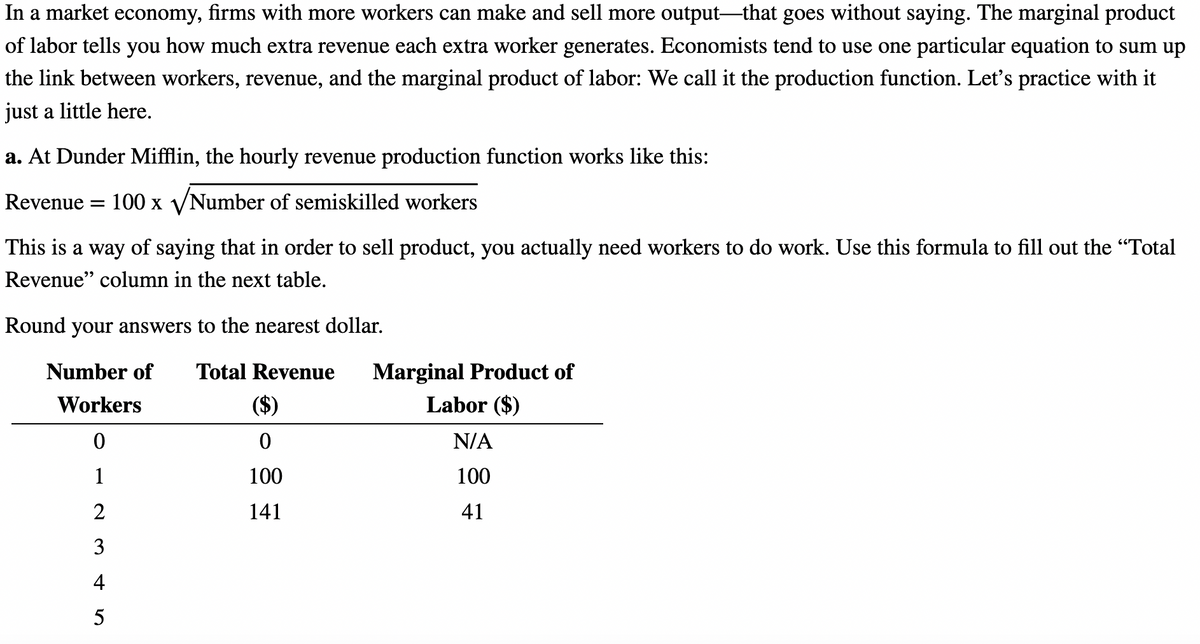In a market economy, firms with more workers can make and sell more output-that goes without saying. The marginal product of labor tells you how much extra revenue each extra worker generates. Economists tend to use one particular equation to sum up the link between workers, revenue, and the marginal product of labor: We call it the production function. Let's practice with it just a little here. a. At Dunder Mifflin, the hourly revenue production function works like this: Revenue = 100 x VNumber of semiskilled workers This is a way of saying that in order to sell product, you actually need workers to do work. Use this formula to fill out the "Total Revenue" column in the next table. Round your answers to the nearest dollar. Marginal Product of Labor ($) Number of Total Revenue Workers ($) N/A 1 100 100 2 141 41 3 4 5
In a market economy, firms with more workers can make and sell more output-that goes without saying. The marginal product of labor tells you how much extra revenue each extra worker generates. Economists tend to use one particular equation to sum up the link between workers, revenue, and the marginal product of labor: We call it the production function. Let's practice with it just a little here. a. At Dunder Mifflin, the hourly revenue production function works like this: Revenue = 100 x VNumber of semiskilled workers This is a way of saying that in order to sell product, you actually need workers to do work. Use this formula to fill out the "Total Revenue" column in the next table. Round your answers to the nearest dollar. Marginal Product of Labor ($) Number of Total Revenue Workers ($) N/A 1 100 100 2 141 41 3 4 5
Chapter11: Profit Maximization
Section: Chapter Questions
Problem 11.8P
Related questions
Question
Total revenue, 3 workers: $
Total revenue, 4 workers: $
Total revenue, 5 workers: $
b. As we mentioned in the chapter, the marginal product of labor is the extra revenue that’s generated by each extra worker. It’s the change in revenue from adding one more worker. Fill out that column, as well. Again, round your answers to the nearest dollar.
Marginal revenue, 3 workers: $
Marginal revenue, 4 workers: $
Marginal revenue, 5 workers: $
c. If the market wage for semiskilled workers is $25 per hour, how many workers should Dunder Mifflin hire?
Optimal number of workers:

Transcribed Image Text:In a market economy, firms with more workers can make and sell more output-that goes without saying. The marginal product
of labor tells you how much extra revenue each extra worker generates. Economists tend to use one particular equation to sum up
the link between workers, revenue, and the marginal product of labor: We call it the production function. Let's practice with it
just a little here.
a. At Dunder Mifflin, the hourly revenue production function works like this:
Revenue
100 x VNumber of semiskilled workers
This is a way of saying that in order to sell product, you actually need workers to do work. Use this formula to fill out the "Total
Revenue" column in the next table.
Round your answers to the nearest dollar.
Marginal Product of
Labor ($)
Number of
Total Revenue
Workers
($)
N/A
1
100
100
2
141
41
3
4
5
Expert Solution
This question has been solved!
Explore an expertly crafted, step-by-step solution for a thorough understanding of key concepts.
This is a popular solution!
Trending now
This is a popular solution!
Step by step
Solved in 3 steps with 2 images

Knowledge Booster
Learn more about
Need a deep-dive on the concept behind this application? Look no further. Learn more about this topic, economics and related others by exploring similar questions and additional content below.Recommended textbooks for you


Exploring Economics
Economics
ISBN:
9781544336329
Author:
Robert L. Sexton
Publisher:
SAGE Publications, Inc

Principles of Microeconomics
Economics
ISBN:
9781305156050
Author:
N. Gregory Mankiw
Publisher:
Cengage Learning


Exploring Economics
Economics
ISBN:
9781544336329
Author:
Robert L. Sexton
Publisher:
SAGE Publications, Inc

Principles of Microeconomics
Economics
ISBN:
9781305156050
Author:
N. Gregory Mankiw
Publisher:
Cengage Learning



Microeconomics: Principles & Policy
Economics
ISBN:
9781337794992
Author:
William J. Baumol, Alan S. Blinder, John L. Solow
Publisher:
Cengage Learning